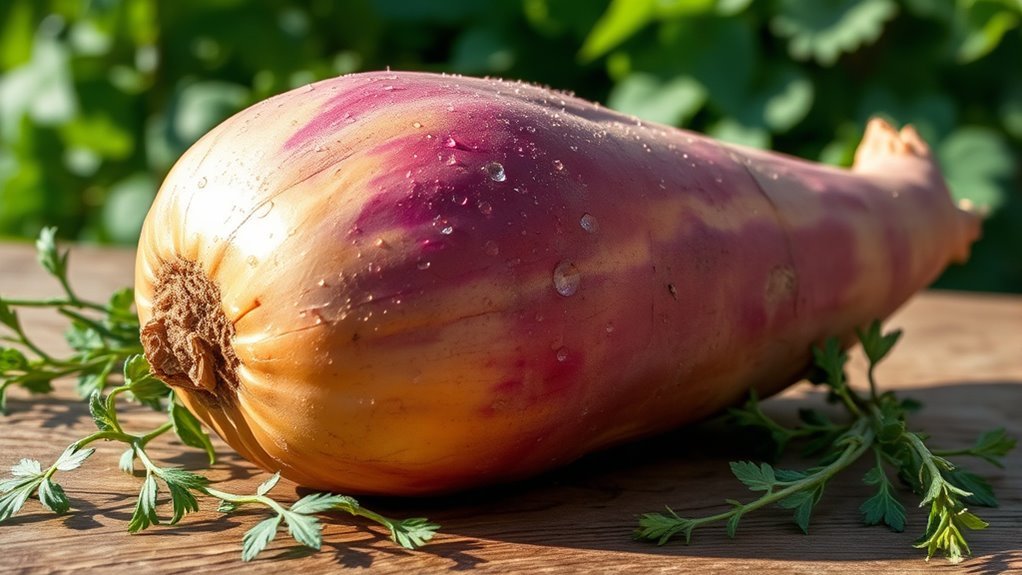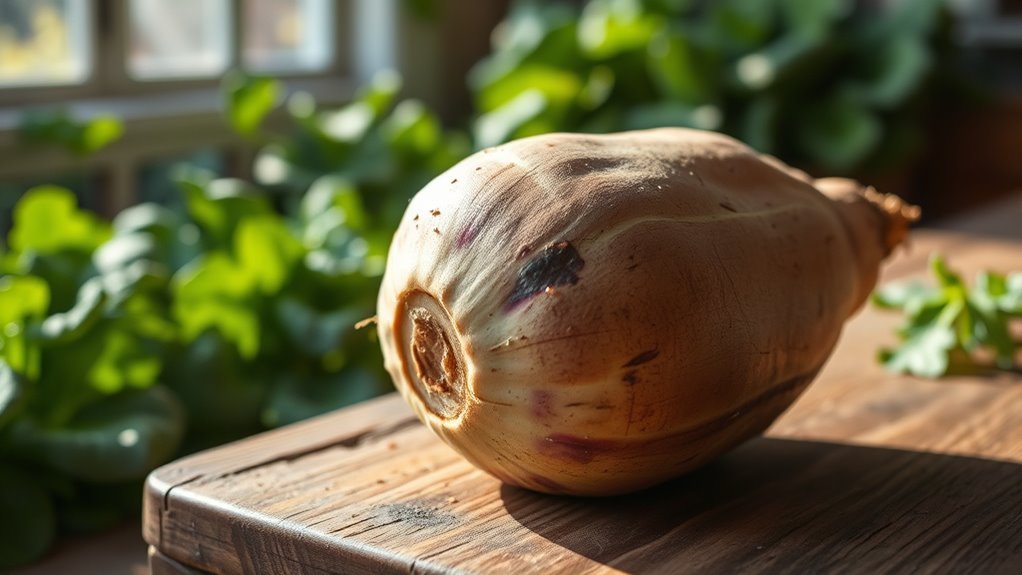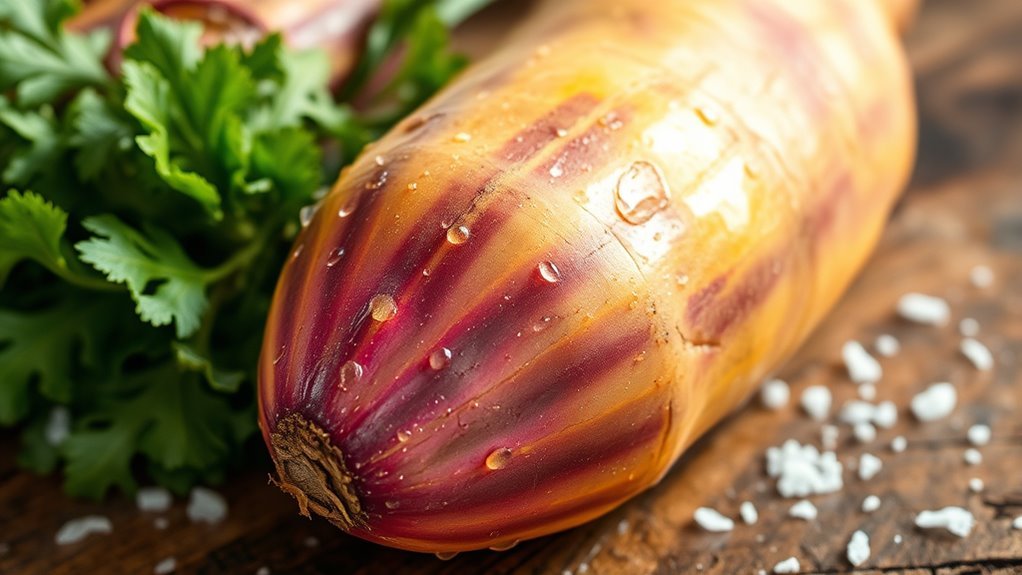Yes, rutabagas can fit into a keto diet. They contain about 8 grams of net carbs per 100 grams, which is manageable for most keto meal plans. These root vegetables are rich in vitamin C, fiber, and essential nutrients while being low in calories. You can roast, mash, or add them to soups, enhancing your meals without exceeding carb limits. If you want to discover creative ways to enjoy rutabagas, continue exploring their culinary potential.
Nutritional Profile of Rutabagas

When you consider incorporating rutabagas into a keto diet, it’s important to understand their nutritional profile. Rutabagas are rich in vitamins, particularly vitamin C, which supports immune function and skin health. They also contain B vitamins, essential for energy metabolism. Their mineral profile is notable, featuring potassium, which helps regulate blood pressure, and magnesium, vital for muscle and nerve function. Additionally, rutabagas provide calcium and iron, contributing to bone health and oxygen transport in the blood, respectively. With a low-calorie count and high fiber content, they can be a satisfying addition to your meals. Understanding these nutritional aspects can empower you to make informed choices that align with your dietary goals while enjoying the versatility of rutabagas.
Carb Content and Keto Compatibility

Although rutabagas are often celebrated for their nutritional benefits, their carbohydrate content plays a critical role in determining their compatibility with a keto diet. With roughly 8 grams of net carbs per 100 grams, rutabagas can fit into your keto meal plan, but moderation is key. You might find that using rutabagas in keto recipes can enhance your meals without exceeding your carb limits.
| Nutrient | Amount per 100g | Keto Compatibility |
|---|---|---|
| Carbohydrates | 8g | Moderate |
| Fiber | 2g | Beneficial |
| Net Carbs | 6g | Acceptable |
Consider incorporating rutabaga recipes as keto snacks, ensuring you stay within your daily carb goals while enjoying their unique flavor.
Health Benefits of Rutabagas

Rutabagas offer a variety of health benefits that can enhance your diet, particularly due to their rich nutrient profile. These root vegetables are an excellent source of vitamin C, which plays an essential role in immune function and skin health. Incorporating rutabagas into your meals can also provide dietary fiber, promoting digestive health and helping to regulate blood sugar levels. Additionally, rutabagas are low in calories while being nutrient-dense, making them a great choice for those looking to maintain a healthy weight. Their antioxidant content may help reduce inflammation and combat oxidative stress. With these health benefits, rutabagas can be a valuable addition to a balanced diet, supporting your overall well-being.
How to Incorporate Rutabagas Into Your Keto Diet
Incorporating rutabagas into your keto diet can be a flavorful and nutritious way to enhance your meals while keeping carbohydrate intake in check. These root vegetables can easily be included in various rutabaga recipes that fit your low-carb lifestyle.
Here are some cooking methods to take into account:
- Roasting: Toss diced rutabagas with olive oil and seasonings for a crispy side dish.
- Mashing: Boil and mash rutabagas as a low-carb alternative to potatoes, perfect for creamy comfort food.
- Soups: Add diced rutabagas to your favorite keto-friendly soups for added texture and nutrients.
Experimenting with these methods allows you to enjoy rutabagas while maintaining your keto goals, ensuring variety and satisfaction in your meals.
Rutabagas vs. Other Low-Carb Vegetables
When comparing rutabagas to other low-carb vegetables, it’s important to contemplate their unique nutritional profile and culinary versatility. Rutabagas offer around 7 grams of net carbs per cup, making them a great option for a keto diet. They’re rich in fiber and vitamin C, providing essential nutrients. Regarding preparation, rutabagas can be roasted, mashed, or even spiralized, adding variety to your meals. When it comes to storage, keep them in a cool, dark place; they can last several weeks if stored properly. In contrast, other low-carb vegetables like zucchini or cauliflower may have fewer carbs but vary in taste and texture. Ultimately, incorporating rutabagas can diversify your low-carb vegetable intake while keeping meals flavorful and satisfying.
Frequently Asked Questions
Can Rutabagas Cause Digestive Issues on a Keto Diet?
Rutabagas can potentially cause digestive issues on a keto diet due to their fiber content. While fiber is essential for digestive health, consuming too much at once can lead to bloating or discomfort, especially if your body isn’t used to it. If you’re considering adding rutabagas to your meals, it’s best to start with small amounts and monitor how your body reacts to maintain a balanced digestive system.
Are Rutabagas Suitable for Vegan Keto Diets?
Rutabagas can be a suitable choice for vegan keto diets. They offer nutritional benefits like fiber, vitamins, and minerals while being low in carbs compared to other starchy vegetables. As a versatile root vegetable, rutabagas can replace higher-carb options in many dishes, providing a satisfying texture. If you’re exploring vegan alternatives, incorporating rutabagas into your meals can enhance flavor and nutrition without compromising your keto goals. Just watch your portion sizes to stay within carb limits.
How Do I Store Fresh Rutabagas?
To store fresh rutabagas effectively, keep them in a cool, dark place, like a root cellar or the vegetable drawer of your fridge. The ideal rutabaga conditions involve maintaining humidity and a temperature between 32°F and 40°F. Avoid washing them until you’re ready to use them, as moisture can lead to spoilage. Proper fresh rutabaga storage can extend their shelf life for several weeks, ensuring you have them on hand for your meals.
Can I Eat Rutabagas Raw?
You might think rutabagas are the superhero of vegetables, and you’d be right! Eating them raw can offer you several nutritional benefits, including a good dose of vitamin C and fiber. Their flavor profile is earthy and slightly peppery, making them a unique addition to salads or slaws. Just remember to wash them thoroughly before consuming. While they’re often cooked, enjoying them raw can be a revitalizing way to incorporate them into your diet!
What Are the Cooking Methods for Rutabagas?
When it comes to cooking rutabagas, you’ve got a couple of great options. Boiling rutabagas is simple—just peel, chop, and simmer until tender. This method helps retain their natural sweetness. Roasting rutabagas, on the other hand, brings out a different flavor profile; toss them with olive oil, seasonings, and roast until golden brown. Both methods can enhance their taste and texture, so feel free to experiment and find your favorite way to enjoy them!


